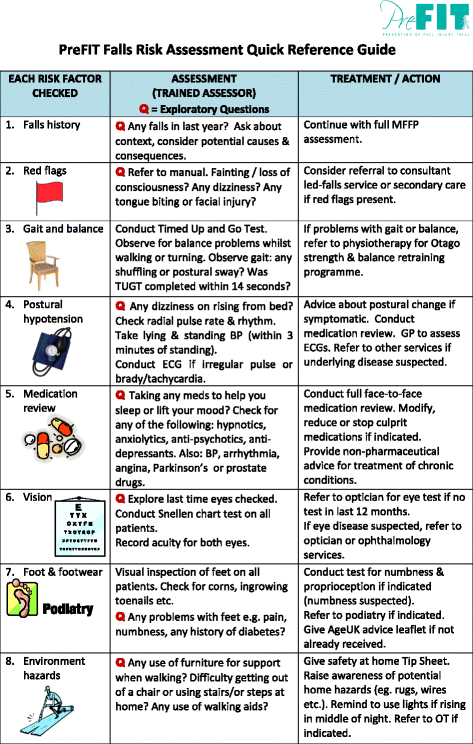The smart Trick of Dementia Fall Risk That Nobody is Discussing
The smart Trick of Dementia Fall Risk That Nobody is Discussing
Blog Article
The Buzz on Dementia Fall Risk
Table of Contents4 Simple Techniques For Dementia Fall RiskUnknown Facts About Dementia Fall RiskNot known Facts About Dementia Fall RiskNot known Factual Statements About Dementia Fall Risk
A loss threat evaluation checks to see exactly how most likely it is that you will fall. The evaluation usually includes: This consists of a collection of questions concerning your overall health and if you have actually had previous falls or issues with equilibrium, standing, and/or walking.STEADI consists of testing, evaluating, and treatment. Treatments are recommendations that may lower your risk of dropping. STEADI includes three actions: you for your danger of succumbing to your threat factors that can be enhanced to try to avoid falls (for instance, balance problems, impaired vision) to decrease your danger of falling by making use of efficient strategies (for instance, supplying education and sources), you may be asked a number of inquiries consisting of: Have you dropped in the previous year? Do you really feel unstable when standing or strolling? Are you stressed regarding dropping?, your provider will certainly test your strength, equilibrium, and gait, utilizing the complying with loss evaluation tools: This test checks your gait.
You'll rest down once more. Your provider will certainly check just how lengthy it takes you to do this. If it takes you 12 seconds or even more, it may suggest you are at greater danger for a fall. This test checks stamina and equilibrium. You'll being in a chair with your arms crossed over your chest.
The positions will obtain more challenging as you go. Stand with your feet side-by-side. Relocate one foot halfway ahead, so the instep is touching the big toe of your other foot. Relocate one foot completely before the other, so the toes are touching the heel of your various other foot.
The 10-Second Trick For Dementia Fall Risk
Most falls occur as a result of several adding variables; as a result, managing the threat of falling begins with identifying the factors that add to fall danger - Dementia Fall Risk. Some of the most appropriate danger aspects include: History of prior fallsChronic clinical conditionsAcute illnessImpaired gait and balance, lower extremity weaknessCognitive impairmentChanges in visionCertain risky medicines and polypharmacyEnvironmental elements can also raise the threat for falls, consisting of: Poor lightingUneven or damaged flooringWet or unsafe floorsMissing or harmed handrails and grab barsDamaged or improperly fitted tools, such as beds, mobility devices, or walkersImproper use assistive devicesInadequate supervision of the individuals staying in the NF, including those that display aggressive behaviorsA effective autumn risk monitoring program needs a detailed professional evaluation, with input from all members of the interdisciplinary group

The care plan should additionally consist of interventions that are system-based, such as those that advertise a safe environment (ideal lighting, hand rails, grab bars, etc). The efficiency of the treatments ought to be examined regularly, and the care plan modified as essential to show modifications in the fall danger evaluation. Executing from this source a fall threat management system using evidence-based best method can minimize the frequency of drops in the NF, while limiting the capacity for fall-related injuries.
Dementia Fall Risk for Dummies
The AGS/BGS guideline suggests screening all adults aged 65 years and older for fall danger annually. This screening includes asking people whether they have dropped 2 or even more times in the previous year or looked for clinical interest for a loss, or, if they have home not dropped, whether they feel unsteady when strolling.
People that have dropped when without injury must have their balance and stride evaluated; those with gait or equilibrium irregularities must obtain extra assessment. A background of 1 fall without injury and without stride or balance issues does not call for more evaluation past ongoing yearly autumn risk screening. Dementia Fall Risk. A loss danger analysis is called for as component of the Welcome to Medicare examination

Some Ideas on Dementia Fall Risk You Need To Know
Recording a drops history is one of the quality signs for autumn prevention and administration. Psychoactive drugs in specific are independent predictors of drops.
Postural hypotension can often be reduced by minimizing the dose of blood pressurelowering medicines and/or quiting drugs that have orthostatic hypotension as a negative effects. Use of above-the-knee support tube and resting with the head of the bed elevated might also lower postural decreases in blood stress. The recommended aspects of a fall-focused checkup are revealed in Box 1.

A TUG time better than or equivalent to 12 secs suggests high autumn danger. Being incapable to stand up from a chair of knee elevation without making use of one's arms shows boosted fall risk.
Report this page